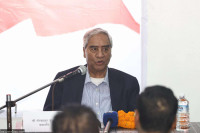Opinion
Nowhere to go
Rainwater fills streets because open areas have been built up and rivers have shrunk
Jagannath Adhikari
About a month ago, I received news about a flood in Pokhara which I understood was surface water flooding due to rainwater not being drained properly. I remembered there was not a single house there, in the area in question, until about 30 years ago, and the rainwater would run into streams. Now the place has been densely built up, and there is no way for the surface runoff to flow down into Phewa Lake.
If a place like Pokhara can get flooded, what can we expect in cities like Kathmandu and Biratnagar where it is easy for rainwater to collect for lack of drainage? We saw how Biratnagar was flooded this monsoon. The picture of an airplane standing in several feet of water in the middle of the runway vividly symbolised the disaster. In Kathmandu, we see waterlogged streets every time it rains. Floodwaters also get into houses and destroy property. The loss of trees and open spaces, and encroachment upon riverbeds has led to urban floods. It is natural for urban settlements to be dense, but planners of settlements, infrastructure and urban space have not considered the natural drainage system.
Concrete jungle
The rapid expansion of built-up areas and open ground being covered by concrete or asphalt has prevented rainwater from percolating into the soil. As a result, groundwater is not being recharged, and there is high runoff of rainwater. I see this in Pokhara nowadays where instances of people, bicycles or motorbikes being swept away by flash floods following heavy rain have become common.
Climate change has compounded the problem of urban floods. With a change in rainfall patterns with a higher frequency of extreme rainfall intensity, incidences of urban floods have increased as excess runoff is not being absorbed into the ground and water flows into the drainage system has been blocked. Moreover, drains have been narrowed or blocked due to encroachment on riverbeds and rivers have shrunk. These are all precursors to floods, and haphazard settlements and faulty planning have created a ripe condition for floods.
The problem of floods in urban areas is not specific to Nepal. During this monsoon season, we saw that big cities in India like Mumbai, Bangalore and Chandigarh also suffered from massive inundation. Apart from urban planning and urban expansion that did not respect the water system, climate change is also believed to have caused this problem. In India this year, there was less than average rainfall, but there was a huge flood problem across the country including in urban areas. Most of the flooded areas used to suffer from a rainfall deficit. In some locations, deficit suddenly turned into surplus, leaving many other areas dry. This was in essence a climate change event, which is now considered as the ‘new normal’ pattern of rainfall.
Short memory
We have a tendency to forget the flood once the water recedes. But it is a long-term problem as its impact continues for some time. Generally, the government bureaucracy considers it a short-term phenomenon, and it gives up its responsibility once the water goes away. But the people need to bear many consequences of the flood for a long time. The coping capacity of flood victims also differs depending on their power and wealth. Wealthy and powerful people can escape from the consequences within a short time as they can move away to a safer place or protect themselves from food shortages, water pollution and health problems that come in the aftermath of a flood. Therefore, it is generally the poorer and marginal areas that suffer most from floods, and this suffering can continue for a long time.
The impact of climate change will, if anything, become more severe in the future, and there is no option for us but to live with it. The best way to make urban areas resilient and able to cope with uncertain floods and reduce adverse impacts is to make local planning and governance sensitive to this problem. This is particularly important given the fact that small rivers, seasonal creeks and surface runoff are seen to be major causes of flood in urban areas. This was clearly evident during the floods in the towns in the Tarai a few weeks ago. Moreover, local agencies were not prepared to issue any warnings about the impending floods.
Like any other disaster, solutions to urban flooding also require effective cooperation of various stakeholders. For this, flood and surface water management plans are important at the municipality level. It is also seen that open green spaces and open public spaces are vital for absorbing excess rainwater. The spaces allocated for excess water drainage could be used for multiple purposes like recreation or cultural conservation, biodiversity and the wellbeing of people. We have seen over the last two or three decades of rapid urbanisation that such open spaces have also been lost. Nevertheless, Nepal is now at the best time to use local governments for developing plans and governance mechanisms to reduce the risk of urban floods.
Adhikari is a human geographer with an interest in development planning




 10.12°C Kathmandu
10.12°C Kathmandu








%20(1).jpg&w=300&height=200)

